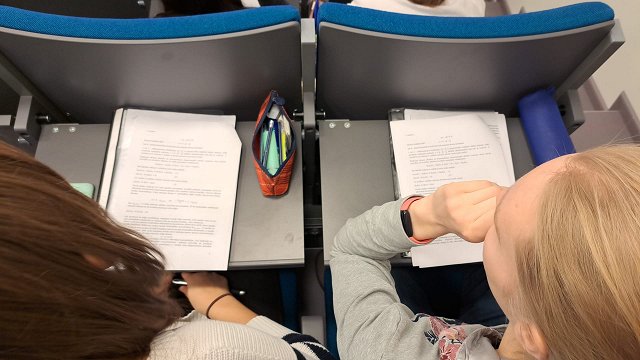Inflation is high in Europe, but it is significantly higher in the Baltic States. The Latvian central bank (Bank of Latvia) estimated that the global prices of energy resources and imported food, partly also wages, represent a significant part of inflation. However, despite these reasons, which account for about two-thirds of inflation, there is a certain proportion of inflation that cannot be explained by these factors, said Uldis Rutkaste, head of the Bank of Latvia's Monetary Policy Board.
"I would explain this by such a phenomenon that, at a time when prices are increasing for objective reasons, there are companies taking advantage of the situation. They add costs to final prices in anticipation of future price increases, or use the situation and increase the price because others are changing the price, although costs have not increased significantly," said Rutkaste.
This suggests that the competition situation in Latvia is not as sharp as in other countries, or there are other economic features that allow the global cost shock to appear more rapidly in Latvia's inflation.
Over the past few years, the share of corporate profits in the economy has increased, and the Bank of Latvia has assessed that it has not deteriorated at this time. This means that companies can transfer price increases to end products fairly successfully. If it didn't, profit margins would deteriorate sharply.
“For example, the manufacturing industry as a whole is showing very good profit indicators, they are even growing. There is also a similar situation in service sectors with sufficiently good profit margins. This shows that the costs can be transferred to end-product prices, and possibly individual companies are able to raise their product prices more rapidly than costs have increased,” Rutkaste said.
Knowing that the increase has been quite large in many cost positions and that it has managed to keep profit rates relatively good, albeit slightly weaker, means that companies have managed to carry a large part of the increase to end products, agreed Swedbank's economist Agnese Buceniece, economist at Swedbank.
According to the economists, profit indicators are resilient in agriculture, though yields need to be taken into account in this sector. At the same time, profitability in information technology services has fallen from very high levels. There is also a decrease in construction, food, and textile products. Meanwhile, in catering and accommodation services, Covid has had its impact. Also in art and entertainment, profitability hasn't returned to the level where it was a couple of years ago.
For example, last year, the Competition Council, in order to find out the reasons for the substantial increase in prices for woodchips, found that there was sufficient competition in the market for chips, namely a large number of operators competing with each other, based on the prices offered. The Council did not see any signs of a cartel on the market, nor did it conclude that no economic operator was likely to be in a dominant position. In addition, the Competition Council pointed out that, in the chip market, operators are likely to make higher profits than usual, but it should be noted that such profits are likely to be a short-term phenomenon.
"Important is demand for certain products, this is one reason the price for chips rose because of a small wave of panic, perhaps speculative actions. Acute demand exacerbated the situation. Niche industries are more likely to increase prices, provided that there is more control over the final price. This can be seen in the IT sector, in computer services where profit margins are higher," Buceniece said.
On the other hand, under the supervision of the retail market in fuel, the Competition Council concluded that competition was at a sufficient level, namely, the fuel market is saturated, and competition between the networks continues to grow, which means that market participants are less likely to exercise their market power. At the same time, the Competition Council, from an analysis of the financial statements of major fuel suppliers and processors, came to the conclusion that it was the refineries that, at a time when retail fuel prices were rising rapidly, were able to generate significantly higher profits than in the previous year. It could also point to a lack of competition in the fuel-recycling market, said Ieva Dāboliņa, director of the Analytic Department of the Competition Council.
Regulatory practices can also be debated and approaches vary from country to country. Latvia's approach is liberal because world prices are quickly transferred to final consumers and tariffs. But perhaps it is also that tariffs have been fixed for many years, and at the moment, for example, energy companies from other countries are facing a completely different situation than those of Latvia. “There are countries where energy companies need support,” said Rutkaste.
“The right balance needs to be found. And perhaps we need to discuss this arrangement in Latvia so that world prices don't come down so quickly to end users. Such an approach would protect consumers more and would be positive until the financial situation of companies is fundamentally damaged,” said the economist at the Bank of Latvia.
The tariffs fixed in Latvia, taking into account various reservations in the agreements, are revised and may have changed several times already. This means that with contracts, companies have insured against price increases, which are reaching users much more quickly.
Whether it is a problem of a small state or economic structure, Rutkaste estimated that businesses in a small country are also smaller. Consequently, it is more difficult for companies to absorb price increases. It is also a matter of financing conditions and the supply of quantities of goods where prices of raw materials are higher at lower levels.
“At some level, it is a matter of a small country, but there are other small countries in Europe, with far less inflation than we have. It is known that the shadow economy is also anti-competitive, and it is quite high for us,” said the Swedbank economist Buceniece.
From an economic point of view, as long as consumption does not fall significantly, companies will not be motivated to absorb some of their costs and will continue to develop price policies so that profits do not fall. So far, Latvia has not seen a significant fall in the economy, but at the beginning of this year the economy and consumption will be stalled. This is likely to help rein in inflation processes.
For various reasons, more competition is always better for the market. This means higher productivity, higher efficiency, which means higher wages, explained Buceniece.
“If margins are not significantly affected in general, this is not a good signal for the economy. Of course, it's good for companies, but just up to a certain moment. People will not be able to continue to buy products in the current fall in purchasing power. It will show in corporate earnings figures. But if it is symptomatic of a lack of competition, we need to think about how to promote it and improve it. The reduction of the shadow economy is very important here,” the economist said.
This is a complex issue, promoting the development of new businesses here and attracting new foreign investment. It is clear that it will be increasingly difficult for companies to pass on the price increases on buyers' shoulders and profit margins will fall. The purchasing power of the population is declining and they are looking more closely at what they spend money on.































